School Sisters of Notre Dame (SSND) joined parishioners and friends in a celebration of thanksgiving for the ministry and presence of SSND at St. Francis de Sales in St. Paul, Minnesota, since 1884. The celebration of the Eucharist in St. Francis de Sales Church began at 4 p.m. and was followed by a reception in the school auditorium.
St. Francis de Sales Convent will be closed by the end of the year, and the four sisters currently living there, Sisters Bernadette Welter, Yolanda Latessa, Veronica Horvat, and Marjorie Rosenau, will move to Mankato.
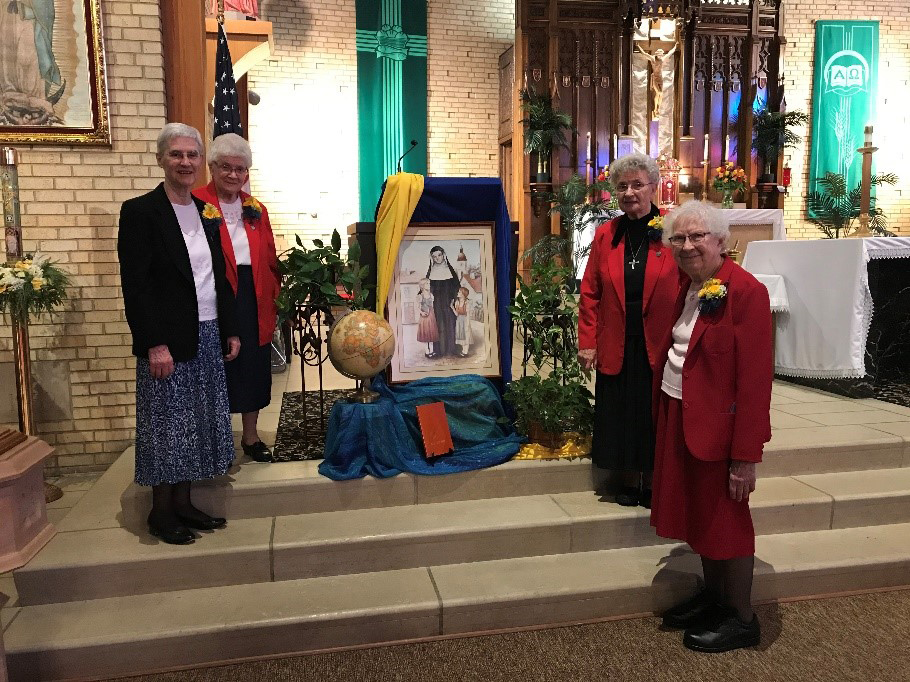
(L to R) Sisters Bernadette Welter, Yolanda Latessa, Veronica Horvat, and Marjorie Rosenau
in St. Francis de Sales Church.
Beginnings
In the 1880s, many German-speaking immigrants were moving to St. Paul, a rapidly growing city where factories, railroads and construction offered them employment and a place to call home. Father John Stariha, an immigrant from Austria, was asked to establish the third German parish in St. Paul, under the patronage of St. Francis de Sales. During the summer months of 1884, Father Stariha had a frame church, rectory, combination school and convent built.
School Sisters of Notre Dame taught at his previous parish in Red Wing, Minnesota, and Father Stariha asked Mother Caroline in Milwaukee to send sisters to the new parish as well. On September 4, 1884, Sisters M. Ermelinda Adams, Leodegar Buescher, Nicolina Schwan, and two candidates, Helen Boschert and Catherine Koetting, accompanied by Sister M. Bathildis Koesterer from Red Wing, arrived in St. Paul.
Sister Ermelinda, the superior of the small community, was born in 1852 in Placerville, California, when it was a mining center during the Gold Rush. A few years later, her family moved to Elm Grove, Wisconsin, where she became acquainted with the School Sisters of Notre Dame. At 32, she was the oldest member of the community.
Both Sisters Leodegar and Nicolina professed their vows in 1883. Sister Leodegar, 23, taught at St. Mary’s School in Milwaukee for two years before coming to St. Francis de Sales where she taught the middle grades. Sister Nicolina, 24, taught in Chilton, Wisconsin, for two years before coming to St. Francis de Sales where she taught the upper grades and singing.
Candidate Helen, 18, taught the lower grades for one year before she was received into the novitiate and given the name Sister M. Agnella. Candidate Catherine, 25, was the only member of the community who was born in Europe. She was placed in charge of the household for one year before she was received into the novitiate and given the name Sister M. Servanda. After her novitiate, she returned to St. Francis de Sales where she served for another 12 years.
After the sisters’ arrival, “the convent and school were put in order as far as possible. . . . Some things were there, but all through each other.” (Convent Chronicle) On September 9, classes began with 134 children in three classrooms, but their number increased rapidly. Additional space was soon needed for both the children and the sisters. Classrooms were added, and a separate convent was built for the sisters in 1885. After it was completed, Sister Ermelinda wrote in the chronicle, “The following week, we moved in. The entire day, one saw a procession of sisters carrying books, pictures, etc., into the new house. In the evening, all were heartily grateful to rest once more in a real bed; for the past months, the school benches had served as beds.” (Convent Chronicle)
The following year, the convent was struck by a fierce storm. “Such fear and such terror none of us had ever experienced. Many thought that the last hour had come since every minute it appeared that the house with its inhabitants would be carried away by the storm.” (Convent Chronicle) The windowpanes were shattered and the sisters took the doors off their hinges and leaned them against the windows. Luckily, it was the only damage sustained by the convent during the storm.
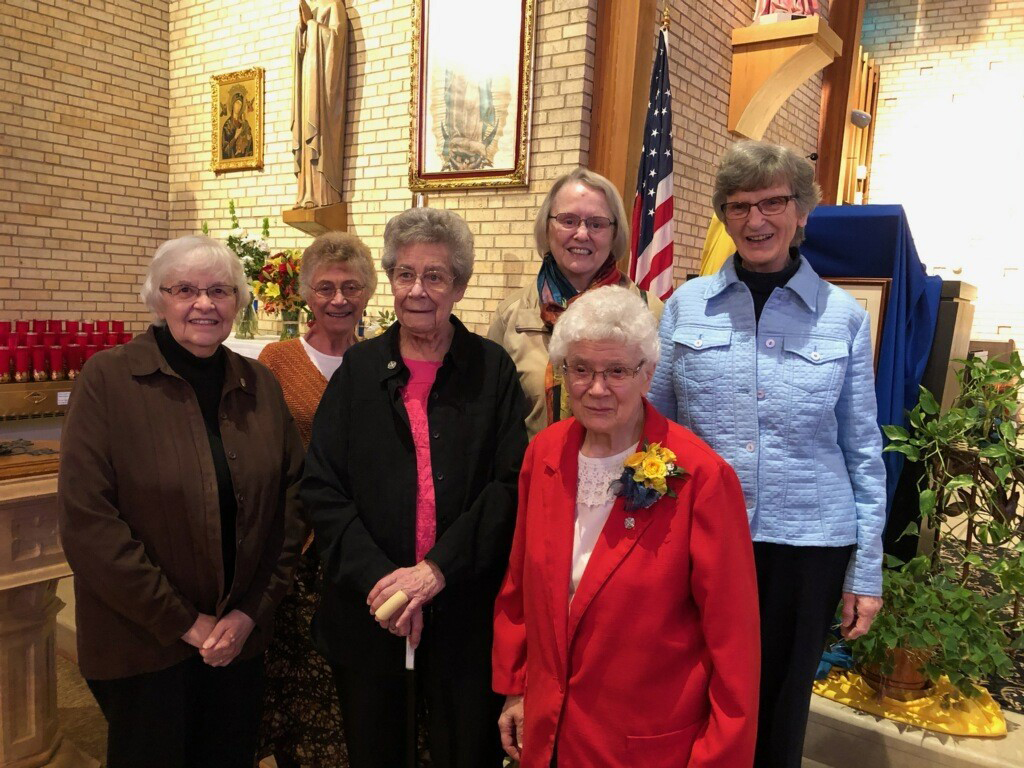
(L to R) Sisters Suzanne Eichler, Kathleen Mary Kiemen, Paulanne Gruber, Mary Anne Schaenzer, Yolanda Latessa,
and Judy Bakula, School Sisters of Notre Dame from St. Francis de Sales Parish, St. Paul, Minnesota.
Theresa Leirich was the first candidate from St. Francis de Sales to enter SSND. When she was 14, she had emigrated with her family from Austria and settled in St. Paul in 1882. Theresa took up sewing and dressmaking and then entered the School Sisters of Notre Dame in 1886. Three years later, she was received into the novitiate and given the name Sister M. Verana. Sister M. Verana’s younger sister Rose followed her in 1895, and was given the name Sister M. Ermelia at reception. They were the first two of more than 30 women from St. Francis de Sales who became School Sisters of Notre Dame.
On January 21, 1888, tragedy struck the small community when Sister M. Nicolina Schwan died after a brief illness. The entire parish mourned the loss of this gifted teacher who had won the hearts of her students. Sister Nicolina was 27 and the first School Sister of Notre Dame who died in the city of St. Paul.
During the first seven years, a male teacher taught the boys in the upper class. After he left in 1891, the sisters took over the boys’ class and, by way of exception, Sister Agnesia Deters, the music teacher and organist, took over the adult choir. This lasted until 1900, when another teacher for the boys and choirmaster was hired. Sister Agnesia had come to St. Francis de Sales after Sister Nicolina died in 1888 and continued her service there until 1933.
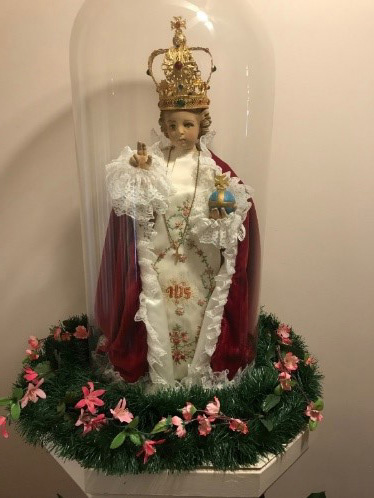
Infant of Prague statue
By 1894, eight sisters were teaching more than 400 children. The school year closed in June with an annual exhibition of the students’ needlework, written compositions and penmanship. Sister M. Cherubim Seubert had come to St. Francis de Sales in 1887, after the church, school and convent at her mission in Henderson, Minnesota, were destroyed by fire. For the next 47 years, she taught needlework and sewing at St. Francis de Sales. She left a legacy of her work by creating elaborate attire for the statue of the Infant of Prague that greeted sisters and guests as they ascended the steps into the convent.
Due to rapidly increasing enrollment, six classrooms were added to the school in 1899.
Early Twentieth Century
The first graduation ceremony was held in 1906, for one boy and three girls who had passed the recently introduced eighth-grade state examinations and received their diplomas.
By 1915, 17 sisters were teaching 570 children. “A new bedroom was prepared on the third floor of the convent and electric lights took the place of gas lighting.” (Convent Chronicle) A short time later, the pastor, Father Francis X. Bajec, had spacious porches added to the convent, “thus giving the sisters the opportunity of enjoying the open night air.” (Convent Chronicle)
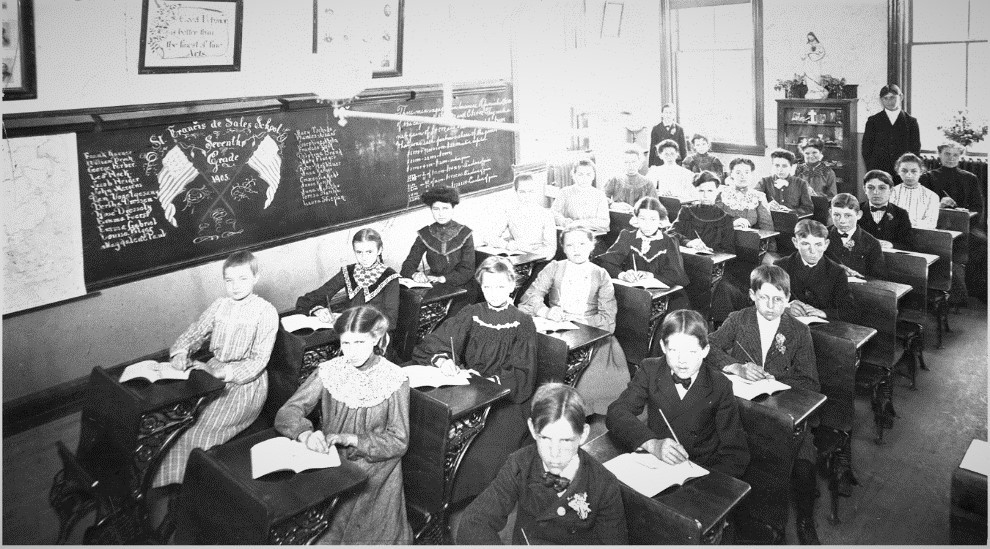
St. Francis de Sales School, Seventh Grade, 1905.
A chapel for the sisters was arranged in the convent on Christmas Eve in 1917. “The large dormitory was emptied two hours before midnight, and a large table that the sisters had brought in served as an altar. All other articles were brought from church before midnight, and even the portable organ was obtained from the school. The chapel and the new sleeping quarters were blessed and the first Holy Mass was offered there at midnight. The sisters sang Christmas carols and received Holy Communion. After Mass, Father Bajec gave a short talk and prayed the Litany of the Infant Jesus.” (Convent Chronicle)
On November 6, 1918, St. Francis de Sales School was closed due to the Spanish influenza epidemic. Sister Fridiana Haus became ill with the flu and died at the age of 30 on November 9. A native of St. Paul, Sister Fridiana was one of the first novices to profess her vows in Mankato in 1913.
St. Francis de Sales reached its peak enrollment of more than 700 students in the 1920s. Older students were taught skills, in so-called commercial classes, to prepare them for future secretarial positions. Classrooms were added wherever space could be found, but the number of sisters did not grow in proportion to the number of students.
Mid-twentieth Century
By 1937, the commercial classes had been replaced by a two-year high school program. Although enrollment had decreased somewhat in the 1930s, it was no longer possible for the old school building to accommodate the needs of the school and parish. A new, fully equipped school with 15 classrooms, an auditorium, social rooms, clubrooms and a bowling alley was built and opened on January 11, 1938.
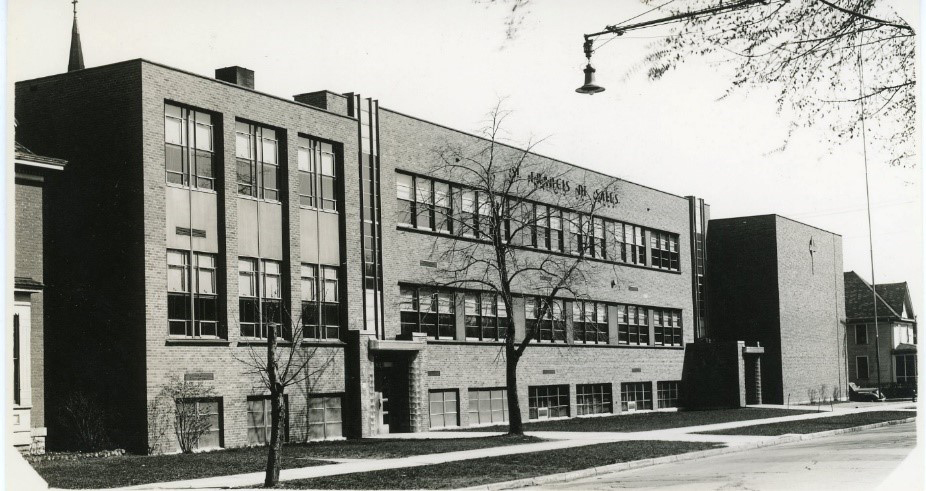
The new St. Francis de Sales School.
In a letter to Mother M. Annunciata, the provincial leader in the former Mankato province, dated May 14, 1946, the eighth-grade class expressed gratitude to the School Sisters of Notre Dame “for all that is being done for us here at St. Francis de Sales School.” The class held a bazaar and was sending the proceeds of $560.00 for the benefit of SSND, “in the war-torn areas of Europe.” (Interprovincial Newsletter, June 1946) Four members of the eighth grade class of 1946, Barbara Gruber, Joan Hau, Irene Komor, and Irene Latessa, eventually became School Sisters of Notre Dame.
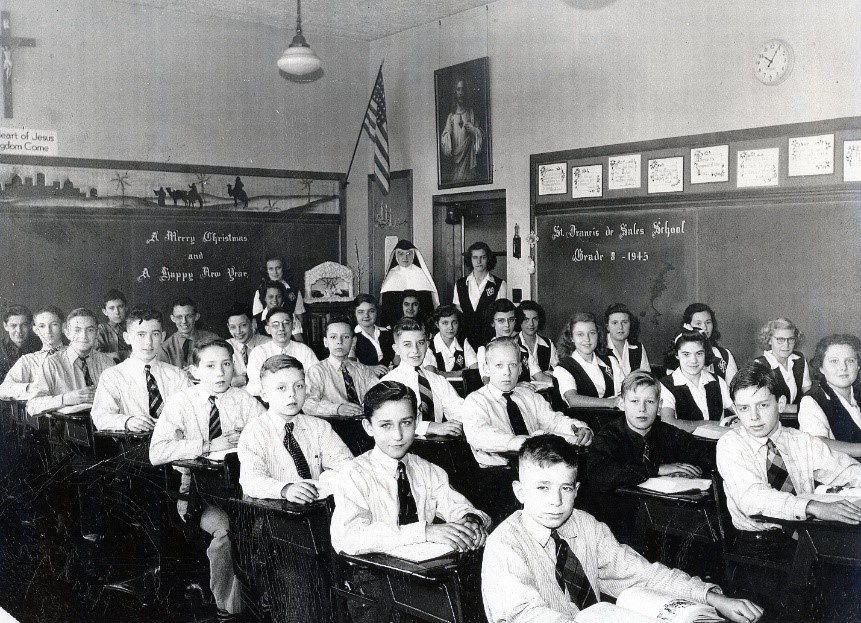
Sister Helene Schmitz with her eighth-grade students, 1945-1946.
Construction of a new convent with private rooms for 24 sisters began in 1949. During the first week of June 1950, the sisters began to move into their new home and to prepare classrooms in the school for their summer guests, sisters who arrived to attend summer school. On June 11, 1950, parishioners and friends were invited for an open house and silver tea – a fundraiser – in the new convent. The proceeds were to be used for new furnishings in the convent. Years later, a sister who had lived in both the old and the new convent exclaimed, “It was a world of difference! The new convent was so spacious and beautiful. It was well laid out, convenient, and comfortable. The sisters’ happiness and gratitude for their new home was deeply felt and tangible.”
One week later, 37 sisters arrived to attend summer school. The second floor in the school had been converted into dormitories and a classroom served as a study hall. Knollwood Motor Bus Company was used to transport the sisters, with the bus arriving at St. Francis de Sales at 7:30 a.m. to take them to the College of St. Thomas or the College of St. Catherine. The bus returned to the colleges at 4 p.m. to bring the sisters home again.
On June 28, the entire convent was blessed and the first Mass was celebrated in the chapel the next morning. On July 4, all the School Sisters of Notre Dame in St. Paul were invited for an open house.
A former student at St. Francis de Sales commented on the welcome and hospitality that she experienced whenever she went to the convent, “The sisters always made us feel at home.”
Late Twentieth Century
Changes brought about by the Second Vatican Council (1962-1965), as well as massive changes affecting all aspects of life in the late twentieth century, had an impact on St. Francis de Sales Parish, School, and Convent. Enrollment at St. Francis de Sales had remained steady during the mid-twentieth century, but after the two-year high school classes were closed in 1963, it dropped to 500 and decreased, slowly but steadily, during the following years. Fewer sisters taught in parish schools or served in parish ministries, and those who did may not have lived in the respective parish convents. On the other hand, sisters whose ministries were not connected with a parish sometimes lived in parish convents with available space. In 1963, 16 sisters called St. Francis de Sales home; by 1978 there were 10.
In 1988, St. Francis de Sales School and St. James School, located a few blocks from St. Francis de Sales, consolidated to form St. Francis-St. James United School. For several years, three sisters who were living in St. Francis de Sales Convent continued to teach or manage the library in the newly consolidated school.
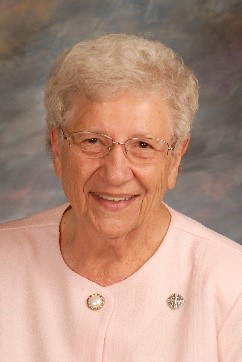
Sister Joan Fink
About the same time, individual sisters living at St. Francis de Sales began to provide home health care services through several different outside organizations. After a number of sisters retired from active ministry, they lived at St. Francis de Sales. However they served, sisters who lived in St. Francis de Sales Convent continued to be a vital part of parish life and ministry.
Beginning in 1997, Sister Joan Fink served as parish minister at St. Francis de Sales. In this position, Sister Joan brought Eucharist to homebound parishioners, visited the hospitalized, and accompanied many families and individuals, especially during times of loss and grieving. She also performed many of the services in the parish that members of the convent community had provided during the parish’s first century. After 18 years of dedicated service, Sister Joan retired in 2015.
Twenty-First Century
At the beginning of the new millennium, 12 sisters called St. Francis de Sales their home. When there was a desire to have a special place for adoration in the parish, the sisters were willing to share their convent chapel. A secure entrance to the Adoration Chapel was built, and the sisters arranged a small chapel for community prayer in another room of the convent.
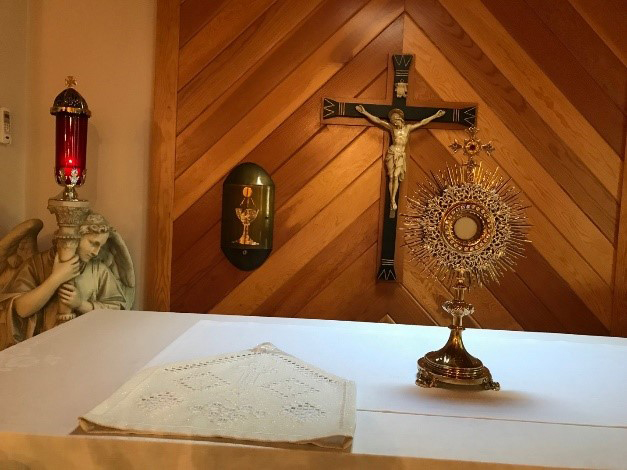
Adoration Chapel in St. Francis de Sales Convent.
St. Francis-St. James United School, with 75 students, closed at the end of the academic year in 2013. According to a newspaper report, “The tiny Catholic elementary and middle school had grappled with shrinking enrollment, changing demographics and a recent loss of rent payments from a charter school tenant.”
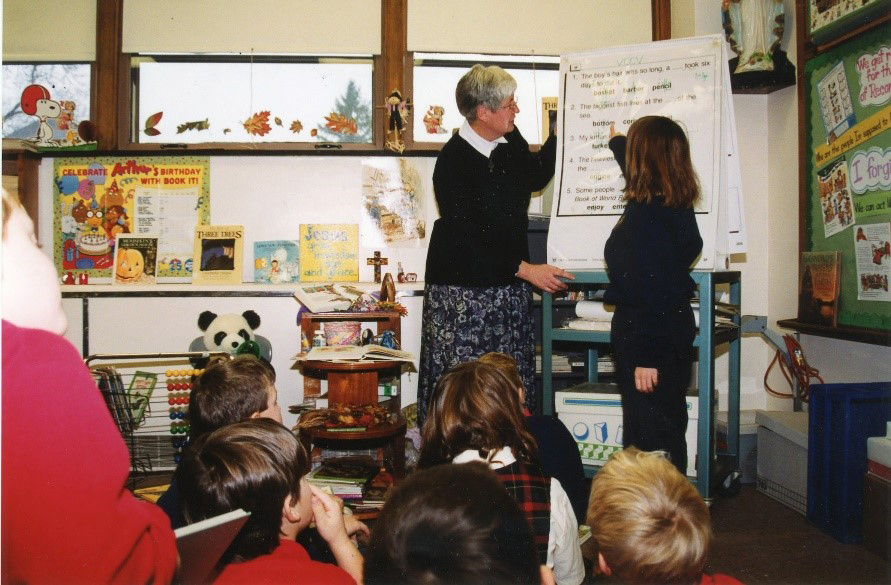
Sister Esther Wagner, the last SSND to teach at St. Francis-St. James United School.
What will be . . .
During the celebration of thanksgiving for the ministry and presence of SSND at St. Francis de Sales on October 26, 2019, Sister Helen Jane Jaeb, Provincial Councilor, shared her reflection, “We are here, in this sacred place, celebrating our mutual gifting. Our SSND community continues to serve those who are in need and those who want to continue, with us, our mission to make one in this time of division. . . . You (St. Francis de Sales Community) gift us with your presence, your support, your love, and the desire to share these gifts, not only with us but with all of God’s creation. . . .
“What will be . . . this is a mystery. However, I can tell you, you will never be forgotten by us. You will be carried in our hearts and in our prayers. You are a part of our family.”
Learn more about the history of the School Sisters of Notre Dame in North America.